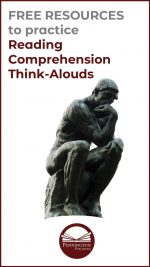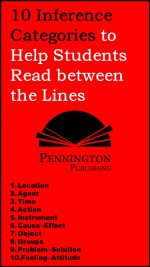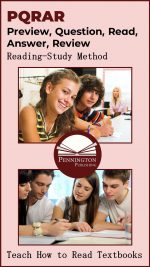How to Teach a Write Aloud
Writing is a complicated thinking process. It requires an enormous amount of multi-tasking, problem-solving, interactivity, and creativity. There is science to effective writing, but there is also art. Unlike reading, which provides the author component of the dialog between reader and text, writing requires the thinker to generate both sides of the dialog. The writer must create the content and anticipate the reader response. Like reading, writing is chiefly learned through direct instruction, modeling, and practice.
Of the three instructional components necessary for effective writing instruction (direct instruction, modeling, and practice), the Write Aloud strategy focuses on the modeling component. In essence, the teacher shows students how he or she composes by thinking out loud and writing out that process so that students can think along with the writer. The Write Aloud is also referred to as “Modeled Writing.”
Writing is certainly not a natural process. Developing writers do not have a priori understanding about how to compose. Thus, teachers play a crucial role in helping to develop good writers.
Teaching students to carry on an internal dialog with their anticipated readers while they write is vitally important. “Talking to the reader” significantly increases writing coherency. Placing the emphasis on writing as the reader will read that writing also helps the writer determine the structure of that writing and so unify the whole.
Good writers are adept at practicing many metacognitive strategies. That’s a big word that means “thinking about thinking.” Students who practice these self-monitoring strategies develop better writing fluency those who do not.
Write Aloud Sample Lesson
1. Select a short, high interest section of dialog from a story familiar to all students. The dialog will help students understand the interactive components of the Write Aloud strategy. Post the dialog on the board, Smartboard®, or display projector. Write this brief prompt, or one of your own, below the dialog: “Analyze the character development in ___________.”
2. Tell them that they are to listen to your thoughts carefully, as you read the brief dialog from ____________, and that they are not allowed to interrupt with questions during your reading. Read the short dialog out loud and interrupt the reading frequently with concise comments about the plot context and what and why the characters are saying what they say. Focus on comprehension, not character development for your first read.
3. After reading, ask students if they think they understood the text better because of your verbalized thoughts than just by passively reading without active thoughts. Their answer will be “Yes,” if you have read effectively. Quickly remind students to listen well and not to interrupt.
4. Tell students that they are now going to learn an important thinking strategy, and that they will listen to your thoughts as an experienced writer. Tell them that your thoughts will not be the same thoughts as theirs. Explain that learning how to think is the focus of this activity, not what to think. Tell them that they can improve the ways in which they think.
5. Tell students that you are going to brainstorm ideas for a character analysis essay during your Write Aloud. Point to the word brainstorm on your Writing Process charts and tell students that you are only going Write Aloud this one part of the process. Remind students that they are to listen to your thoughts carefully, but they are not allowed to interrupt with questions during the activity.
6. Now, read the prompt out loud and define analyze as “to break apart the subject and to explain each part” as if you are reminding yourself of the definition. Re-read the dialog out loud and interrupt the reading frequently with concise comments about how the characters are saying what they say. Write down your comments below the dialog in a graphic organizer. Explain that you are going to use a mapping, a.k.a. bubble cluster, graphic organizer to brainstorm your ideas because it will help you organize your thoughts and allow you to add on new ones as you think of them. Focus your comments (and writing) on these four components: character personalities, descriptions, motives, and author word choice. Ask if the organization and comments will make sense to the reader. Don’t ramble on with personal anecdotes. Comment much more on the text than on your personal connection with the text.
7. After reading, ask students if listening to you think and watching you write down your thoughts helped them understand how the characters are saying what they say. Their answer will be “Yes.” Ask students to repeat what you said that most helped them understand your thinking process. Ask students how they would think differently about what to write, if they were teaching the Write Aloud.
8. Post two new dialogs on the board, Smartboard®, or display projector with the same prompt as above.
9. Group students into pairs and have students practice their own Write Alouds, using the two dialogs. This can get quite noisy, so establish your expectations and remind students that they will be turning in their graphic organizers.
10. Repeat the Write Aloud procedure often with different components of the Writing Process, with or without different prompts, and with different writing tasks or genre.
*****

TEACHING ESSAYS BUNDLE
The author’s TEACHING ESSAYS BUNDLE includes the three printable and digital resources students need to master the CCSS W.1 argumentative and W.2 informational/explanatory essays. Each no-prep resource allows students to work at their own paces via mastery learning. How to Teach Essays includes 42 skill-based essay strategy worksheets (fillable PDFs and 62 Google slides), beginning with simple 3-word paragraphs and proceeding step-by-step to complex multi-paragraph essays. One skill builds upon another. The Essay Skills Worksheets include 97 worksheets (printables and 97 Google slides) to help teachers differentiate writing instruction with both remedial and advanced writing skills. The Eight Writing Process Essays (printables and 170 Google slides) each feature an on-demand diagnostic essay assessment, writing prompt with connected reading, brainstorming, graphic organizer, response, revision, and editing activities. Plus, each essay includes a detailed analytical (not holistic) rubric for assessment-based learning.









